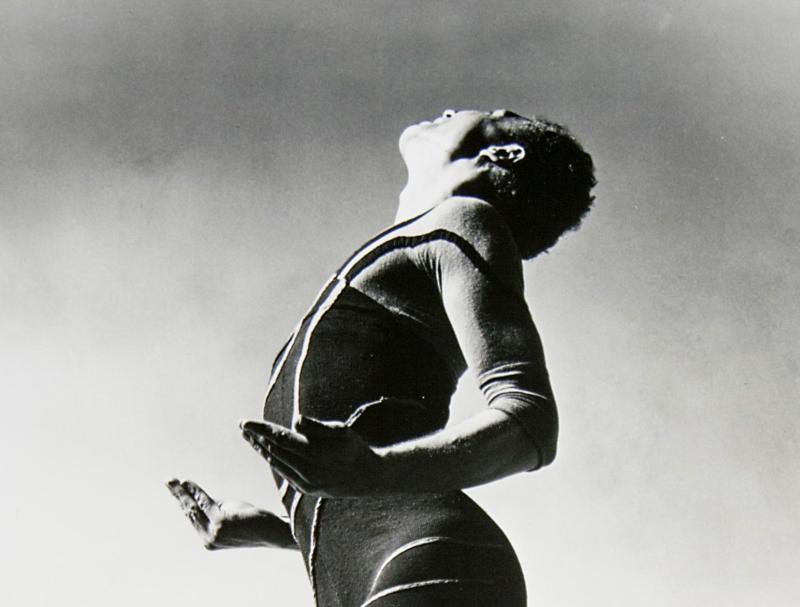Bodies in Motion: In a First, U.Va. Students Curate Fralin Exhibit

As part of an innovative arts internship program this year, University of Virginia students have been exploring The Fralin Museum of Art’s collection, looking for photographs that illustrate the various movements of the human body.
The results of their search are now on view. “The Body in Motion” marks the first time U.Va. students have served as sole curators of an exhibit at The Fralin. Previously, students have only assisted professors in specific curating tasks.

The exhibit, which runs through Aug. 2, features important works from The Fralin’s collection by celebrated photographers including Weegee, Gary Winogrand and Barbara Morgan (whose photos depict famed dancers Martha Graham and Merce Cunningham).
M. Jordan Love, The Fralin’s academic curator, directs the internship program, a two-semester sequence of two three-credit courses. Students participate in internships for an entire academic year, at either The Fralin or the Kluge-Ruhe Aboriginal Art Collection.
This academic year, 10 students worked as interns for about 100 hours each semester in the museum, and took part in three training sessions and three academic seminars.
For Love, the museum internship curriculum has a real-world purpose. “Looking at and handling objects gives context to more abstract academic disciplines, such as history and politics, that students learn in a classroom setting,” Love said.
Since joining the museum staff in August 2012, Love has focused on developing educational programming around the museum’s exhibitions that enhances the learning of students all over the University. Last year, 20 percent of the departments in the College and Graduate School of Arts & Sciences had a museum component in their curriculum, and more than 1,200 of U.Va.’s undergraduates used the museum for some of their academic work.
In Love’s internship courses, students work under the close supervision of museum professionals, take lectures on museum history and practice, and participate in workshops on art handling, installation, conservation and educational programming.
“This class is a perfect example of the kind of hands-on experience that [U.Va.] President [Teresa A.] Sullivan has proposed as a goal for U.Va. and that President Obama has called for internationally,” Love said. “In a country where so many internships are brief and unpaid, this is an internship program for which students receive academic credit and nine months of continuous training before they even graduate. Many universities only offer this level of experiential study in a master’s degree program.”
The students chose the exhibit’s theme. To keep it simple, the only parameter for their exhibit was that the selected art must consist of works on paper, since art that requires pedestals or conservation would require a great deal of money and time.
The Fralin Museum of Art holds more than 14,000 works in its collection, so there was not enough time for the students to thoroughly examine all of them. Instead, Love presented the students with contact sheets of more than 200 thumbnail images of different photographs, drawings and prints to give them ideas.
She also gave the students a list of exhibition themes that the museum had considered in the past – but they weren’t required to choose from that list. And they didn’t.
While poring over the images from museum’s permanent collection, the students were drawn toward photographs of the body in motion.
After setting the theme, the interns selected the photos they would like to curate. They were responsible for researching the work, writing exhibit labels, arranging the exhibition, distributing press releases and creating accompanying educational programs, including public tours and activities for children.
“The 10 of us planned and implemented the exhibit from beginning to end,” said Madeline “Maddy” Smith, a fourth-year student majoring in American studies and English with an arts focus in American documentary film and museum education. “It was incredible to see an idea grow from birth to fruition.”
According to the students’ description of their exhibit, many of the photographs on exhibit incorporate purposeful and organized dance, while others are more instinctive and natural. In the selection process, they soon recognized that the ongoing cultural interest in the action shot – especially when it comes to dance and sports – reflects an amazement with the capability of the human body.
With a special emphasis on 20th-century photography, the students’ exhibition explores the various ways in which the body expresses itself, encourages the contemplation of the body’s motion through imagery and highlights the extent to which people push the boundaries of their bodies.
“Professor Love’s class exposed us to the many sides of working in a museum,” Smith said. “The class was unique because it combined hands-on learning with interesting lectures that allow us to think further about what it means to be part of the museum world.
“Getting to create an actual museum exhibit as an undergraduate is truly an amazing experience.”
The exhibition is made possible through the support of the Andrew W. Mellon Foundation, as well as Art$, the Suzanne Foley Endowment Fund, WTJU 91.1 FM, Albemarle Magazine and Ivy Publications LLC’s Charlottesville Welcome Book. The Fralin Museum of Art’s programming is made possible by the support of The Joseph and Robert Cornell Memorial Foundation.




